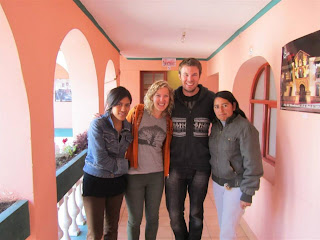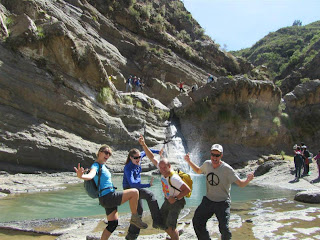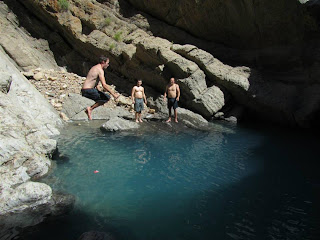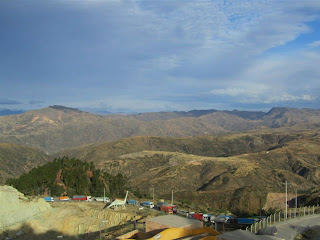Apart from a few lessons we took in Auckland before we left NZ, which we didn’t take too seriously, we had very little Spanish for the first 4 months of travelling. While hostels and tourist agencies usually had someone who spoke English we wanted to be a bit more independent, get off the tourist trail a little and have the opportunity to speak to some of the local people.
 |
| The lookout over the city. |
Sucre is the official capital of Bolivia and where most of the old money is. The pretty town centre comprises of lovely old plazas and colonial buildings as well as some amazing markets. Property prices are higher in Sucre than anywhere else in Bolivia. It is also a university town and as such a great place to chill out and learn Spanish for a few weeks. We also decided to stay with a local family in a homestay to encourage us to use the Spanish we learned in class. Private classes were really cheap and we had four hours per day of one-on-one classes, 5 times a week.
 |
| Our homestay house. |
 |
| Abi and Maria – nuestros profesoras. |
We stayed with lovely family in on of the grandest houses in Sucre. The father was a gynecologist, and the three story house came complete with over 7 bedrooms and bathrooms and a number of dining rooms and lounges.
Not what we were expecting in Bolivia, South Americas poorest country. We lived with three other students which was great fun but probably didn’t help our Spanish much, as the default language was usually English. The food in Bolivia is amazing and everyday we had a three course lunch of soup, a main and dessert. Mid week was pretty hard core, we had forgotten how tiring studying is. But at the weekend we got to relax and visit some other interesting places close by.
El Parque Cretácico
 |
| An actual dinosaur print. |
Bolivia, amoung its many other claims to fame, also has the largest amount of dinasour tracks in the world. Just outside of Sucre stands a giant wall oer 150 meters high which has over 600 dinasours tracks. It was descovered in 1994 by workers of the local cement factory who were quarrying in the area. The once boggy mud flat, created over 65 million years ago, has since been pushed up platonic movement and now stands vertical. The tracks of over 150 different species can be seen, some over 80cm in diameter.
 |
| Telescopes for viewing the tracks. |
The information centre also has some life size models of the dinosaurs complete with speakers throughout playing terrifying dinosaur sounds. While you can’t help feeling a little like you’ on a Jurassic Park ride at Disneyland, the giant wall of tracks is really impressive and reminds us of how short and insignificant our lives are in the grand scheme of things.
 |
| Huge. |
 |
| 65 million years of history. Mind blowing. |
Siete Cascadas – The Seven Waterfalls
 |
| The first cascada. |
 |
| Bone-chilling water, straight from the snow-capped mountains. |
While it was very warm in the sun, the water, which came from further up the mountains, was icy cold. Aoife and Tiffany, homestay sisters, didn’t risk the cold water, but the boys all jumped in. The water was really clean and the surroundings were beautiful, but unfortunately there was quite a bit of rubbish. Like many places we’ve visited, rubbish doesn’t seem to bother the locals like it does in Ireland and New Zealand. Previous picnicers obviously just left their coke cans and food wrappers behind without considering how it spoils the experience for others. Hopefully this is one aspect of Bolivia which will slowly improve as more money trickles into the economy.
Cementerio
 |
| Spaces for rent |
 The city cemetery in Sucre is another fascinating place to visit and is very unlike any graveyards in Ireland or New Zealand. The Many past political figures and richer families were buried there, their tombs complete with small alters and sitting areas. Everyone else has a coffin-sized cement box within a wall, which can be rented for 50, 100 or 150 years if money is an issue. Once a person´s time is up, they´re removed and their space is back on the market.
The city cemetery in Sucre is another fascinating place to visit and is very unlike any graveyards in Ireland or New Zealand. The Many past political figures and richer families were buried there, their tombs complete with small alters and sitting areas. Everyone else has a coffin-sized cement box within a wall, which can be rented for 50, 100 or 150 years if money is an issue. Once a person´s time is up, they´re removed and their space is back on the market.
Bolivia is relatively socialist and many of the large unions had there own 3, 4 or 5 story building complete with hundreds of burial spaces for their members. The cemetery was beautifully kept, with gardens constantly trimming the trees and watering the plants. The dead are very important in South America and most of the graves has fresh flowers and looked regularly visited.
Festivals and blockades
The first weekend was the festival of the dance where stages were set up in the main square and all the different dances of Bolivia were performed, modern and traditional. There was also a giant international fashion show and fireworks show, and many other smaller bands and random cultural dances celebrating anything and everything from random saints days to International Children’s Day.
Leaving Bolivia, the main road from Bolivia to Peru was closed in part, and many other roads throughout the country, for another sports festival so the children from the local schools could play games on the road. In any other country this would and not not happen. Economists would be calculating how much money it cost the economy to have the main road closed for a day and the disruption to local businesses would be of greater concern than allowing a few children to play on the road.
While we were in the country there were giant demonstrations throughout the country, but centered in part on Sucre, to object to rising petrol costs and low wages. Many of the main roads in and out of the city were blocked by buses and trucks preventing goods from been taken into the city, driving the cost of food up. People had to get transport to the blockades, walk for up to two hours through them, and get alternative transport on the other side to continue on their journey. This continued for over a month and cost the country over a million dollars per day in tourism alone. Who knows what the total cost was. Even Sucre airport was blocked off but thankfully were were leaving on a Saturday morning and many of the drivers went home to their families at the weekend and it was possible to get through.
It is one of the great things about Bolivia but also what is holding it back. The instability creates a unique culture where things are generally more laid back and people are prevented from taking things too seriously as no one knows what tomorrow will bring. But it also prevents people from making real plans and progressing. How can people expect to open businesses and employ people when there could be a new government in the morning who changes the current legal system completely, where strikes could prevent any customers from finding their business for months on end and their supply chain is cut off because of someone else´s dispute. There are no easy answers and while Bolivia does need stability and structure, I hope it doesn´t lose a bit of itself along the way.


